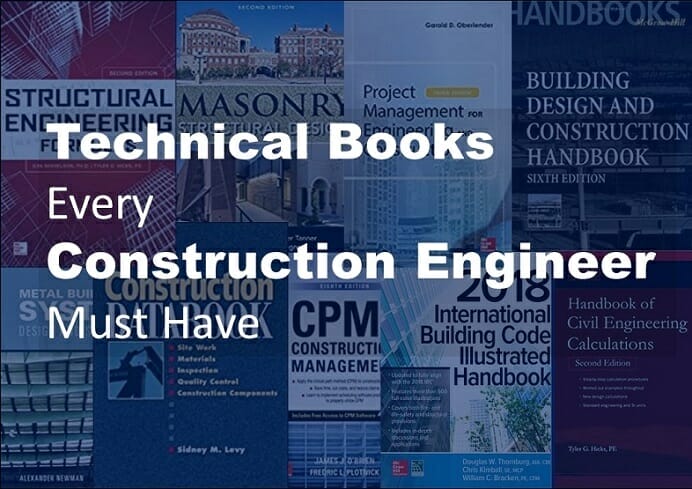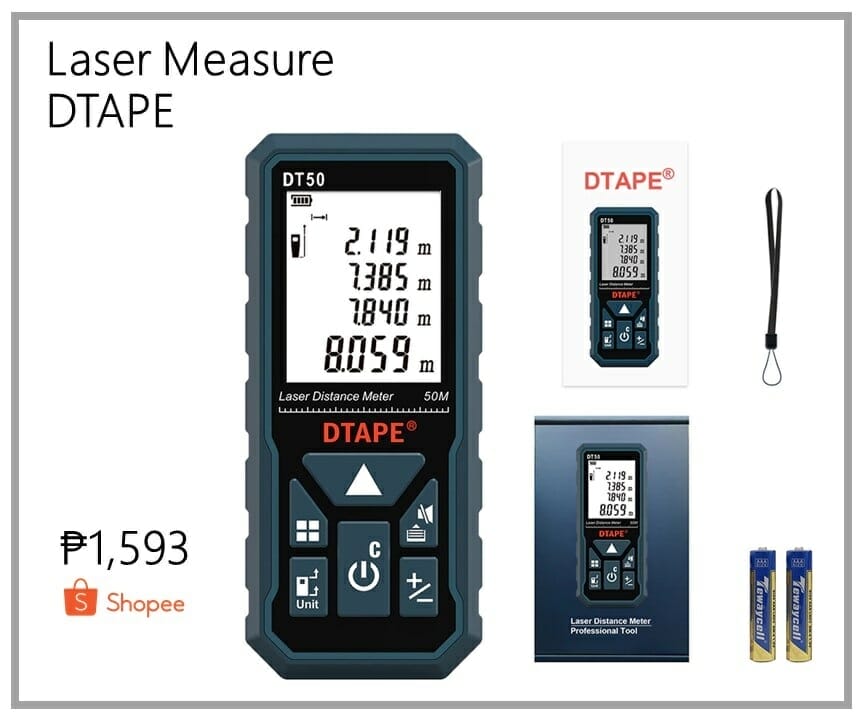Every construction engineer must have at least two…
Many civil engineers, especially those involved in the field of building and construction, often rely on stored knowledge to perform their responsibilities while on site or at work. While that is often risky, it pays for such engineers to have technical books, which can just be right in their pockets through their smartphones, holding critical information that they can go to at times in need.
Listed below are technical engineering books that are building and construction essentials. Topics vary from calculations to project management, already updated in their codes and specifications, suited to the wide tasks that engineers in mentioned field cover.
1. Handbook of Civil Engineering Calculations
by Tyler G. Hicks
Source: Amazon (Construction engineer must have books)
This authoritative reference offers a sure-fire way to save time handling routine and non-routine calculations in the design, rehabilitation, and maintenance of all types of structures. Each calculation procedure includes a worked-out example with numbered steps.
Manage everyday calculations instantly and accurately-saving you time in the design, construction, and maintenance of all types of structures
Covering all aspects of civil engineering calculations in an easy-to-understand format, the new edition of the Handbook of Civil Engineering Calculations is now revised and updated with over 500 key calculations that show you exactly how to compute the desired values for a particular design-going quickly from data to finished result.
Using both customary and SI units, this comprehensive engineer’s must-have resource is exactly what you need to solve the civil engineering problems that come your way. From structural steel to reinforced concrete, from bridges and dams to highways and roads, Handbook of Civil Engineering Calculations, 2e, lets you handle all of these design calculations quickly-and more importantly, correctly.
What’s Inside This Cutting-Edge Engineering Calculations Guide:
Structural Steel Engineering and Design • Reinforced and Prestressed Concrete Engineering and Design • Timber Engineering • Soil Mechanics • Surveying, Route Design, and Highway Bridges • Fluid Mechanic, Pumps, Piping, and Hydro Power • Water Supply
2. Building Design and Construction Handbook
by Frederick S. Merritt, Jonathan T. Ricketts
Source: Amazon (Construction engineer must have books)
A where-would-you-be-without-it handbook covering every single important step in building design and construction, now updated to include key changes in design and construction practices. Surveys materials, structures, soil mechanics and foundations, building types, hardware, insulation, acoustics, plumbing, and more–all the material that will help architects, engineers, contractors, and others work better, faster, and smarter. Includes new design specifications; the latest developments in seismic and wind design criteria; new building systems and material; updated building codes throughout; NFPA requirements; and new wood material and codes.
From the Back Cover
3. International Building Code Illustrated Handbook
by The International Code Council, Douglas W. Thornburg, AIA, C.B.O., John R. Henry, P.E.
Source: Amazon (Construction engineer must have books)
An easy-to-use visual guide to the 2018 International Building Code®. Thoroughly revised to reflect the International Code Council’s 2018 International Building Code®, this full-color guide makes it easy to understand and apply complex IBC® provisions and achieve compliance. With an emphasis on structural and fire- and life-safety requirements, this practical resource has been designed to save time and money.
Douglas Thornburg, AIA, CBO., is the Vice President and Technical Director of Products and Services at the International Code Council (ICC), where he provides leadership in the technical content development of ICC publications and educational s programs as well as instruction of ICC building code seminars. Prior to joining the ICC in 2004, he served as a code consultant and educator for building codes. He has been involved extensively in building code activities since 1980.
Chris Kimball, SE, MCP, is the founder of Kimball Engineering and the Utah Regional Manager at West Coast Code Consultants, Inc. A practicing structural engineer, he holds ICC certifications as a plans examiner, commercial inspector, residential inspector, residential plans examiner, and fire plans examiner/inspector. Chris is an instructor of ICC building code seminars.
William C. Bracken, PE, CFM, is the founder and CEO of Bracken Engineering. His practice specializes in structural, building envelope, general civil, floodplain, construction, building applications, and forensic engineering projects as well as Urban Search and Rescue responses. Bill is an instructor of ICC Disaster Response Institute and building code seminars.
4. Project Management for Engineering and Construction
by Garold D. Oberlender, Ph.D., P.E.
Source: Amazon (Construction engineer must have books)
The latest, most effective engineering and construction project management strategies. Fully revised throughout, this up-to-date guide presents the principles and techniques of managing engineering and construction projects from the initial conceptual phase, through design and construction, to completion.
Garold Oberlender, Ph.D. (Stillwater, OK) was professor and coordinator of the graduate program in construction engineering and project management in the School of Civil Engineering at Oklahoma State University. He is the coauthor of Estimating Construction Costs, Fourth Edition.
5. CPM in Construction Management
by James J. O’Brien, P.E., PMP, CVS, Fredric L. Plotnick, Ph.D., Esq., P.E.
Source: Amazon (Construction engineer must have books)
Advance your construction projects with CPM and this fully updated guide. Plan, schedule, and manage construction projects using the critical path method (CPM) and the practical information contained in this thoroughly revised book.
James J. O’Brien, PE, PMP, CVS, was vice chair of the board of O’Brien-Kreitzberg & Associates, Inc., the construction management firm that handled the renovation of San Francisco’s cable car system. He was also the program manager for the redevelopment of JFK International Airport. Mr. O’Brien is the author or editor of many other books, including [italics start]Contractor’s Management Handbook,[italics end] Second Edition; [italics start]Construction Management: A Professional Approach; Value Analysis in Design and Construction;[italics end] and [italics start]Scheduling Handbook,[italics end] all published by McGraw-Hill. He is a registered Professional Engineer in New York, New Jersey, Pennsylvania and many other states. Mr. O’Brien is a Fellow of the American Society of Civil Engineers, the Project Management Institute, the Construction Management Association of America and the Society of American Value Engineers International. He is also an active member of the Association for the Advancement of Cost Engineering International. Mr. O’Brien is a charter member and a vice president of the PMI College of Scheduling.
Fredric Plotnick is an Adjunct Professor of Engineering in the departments of Engineering Management, Civil Engineering, and Construction Management at Drexel University’s Philadelphia Pennsylvania Campus, where he has taught Engineering Law, Contracts Specifications and Law, Techniques of Project Controls, Project Scheduling and several other subjects since 1979. He has also maintained a consulting practice, Engineering and Property Management Consultants, Inc., since 1983, having previously worked for several contracting, consulting and engineering design firms. Professor Plotnick is a graduate of Drexel University College of Engineering, having a BSCE in Soil and Foundation Engineering and an MSCE in Construction Management, followed by a JD from Widener University School of Law, and returning to Drexel for his PhD in Civil Engineering. He is the co-author of CPM in Construction Management, fifth, sixth and seventh editions, also by McGraw-Hill, and numerous industry publications and presentations. Professor Plotnick is also the developer of the RDM (Relationship Diagramming Method) variant of CPM Planning and Scheduling Analysis which is currently being adopted by software vendors such as Oracle/Primavera starting with the high end, risk analysis product, Pertmaster (version 8.2 et seq.)
6. Construction Databook
by Sidney M. Levy
Source: Amazon (Construction engineer must have books)
Stay on top of construction details and procedures with the help of this illustrated data handbook. It offers fast access to hundreds of tables, charts, diagrams, and illustrations, covering all the components of construction utilized at a typical job site.This complete reference manual will provide you wiht a single source of specifications, codes, checklists, conversion factors, and “how-to” instructions for the most commonly used construction materials, including lumber, masonry, concrete, steel, doors, windows, hardware, and mechanical and electrical components.
Your quick-reference guide to details and procedures for keeping any construction project on track. Stay on top of construction details and procedures with the help of this desk-top data handbook. It offers you fast access to hundreds of tables, specifications, charts, diagrams, and illustrations, covering all of the materials and components of construction most frequently utilized at a typical job site: lumber, masonry, concrete, steel…doors and windows…mechanical and electrical hardware. Whether you work in the commercial or residential markets, this is the one-stop source for what you need to make any construction project run more smoothly. With this guide, you can: access scores of diagrams of wood framing, masonry construction, flashing details, and fire-rated and acoustical drywall framing systems; check the many specification tables to ensure that you are ordering the proper materials for the job. use the cut-away sections and schematic drawings to learn more about HVAC, plumbing, electrical, and energy systems; consult the metrification tables and conversion factors for jobs involving dual measuring systems.
Sidney M. Levy is a construction consultant with more than 40 years experience in the industry. He is the author of 11 books, including several devoted to international construction. Mr. Levy is the author of Project Management in Construction , published in both English and Spanish editions, and he is currently working on the 3rd edition of this book.
7. Metal Building Systems: Design and Specifications
by Alexander Newman, P.E., F.ASCE
Source: Amazon (Construction engineer must have books)
The most complete, up-to-date metal building systems guide. Fully revised for the latest building codes and industry trends, Metal Building Systems, Third Edition, explains how to select, specify, and design pre-engineered buildings with confidence.
Alexander Newman, P.E. (Needham, MA), is principal structural engineer with Maguire Group, Inc. He conducts seminars on metal building systems for design professionals sponsored by the American Society of Civil Engineer, and teaches at Northeastern University.
8. Masonry Structural Design
by Richard E. Klingner
Source: Amazon (Construction engineer must have books)
Complete details on masonry materials and structures Masonry Structural Design covers the basic performance and specification of masonry materials, the basic behavior of masonry wall systems, and the structural design of masonry in the context of the 2009 IBC and the 2008 JSJC Code and Specification.
Jennifer Eisenhauer Tanner, Ph.D., P.E., FACI is an Associate Professor of Civil and Architectural Engineering at University of Wyoming, Laramie, Wyoming. She has practiced professionally as a consulting engineer with Atkinson-Noland & Associates and is a member of The Masonry Society and the American Concrete Institute.
Richard E. Klingner, Ph.D., P.E., FTMS, FACI, is Professor Emeritus in Civil Engineering at the University of Texas at Austin, where he has taught courses in architectural engineering, structural engineering, and transportation engineering.
9. Structural Engineering Formulas
by Ilya Mikhelson, Ph.D., Tyler G. Hicks, P.E.
Source: Amazon (Construction engineer must have books)
PRACTICAL, PORTABLE, AND PACKED WITH UP-TO-DATE STRUCTURAL ENGINEERING FORMULAS
Thoroughly revised with more than 300 new formulas,this compact yet comprehensive compilation puts essential data related to the design and analysis of engineeringstructures at your fingertips. StructuralEngineering Formulas, Second Edition covers a wide range of topics, including statics, soils, foundations, retaining structures, pipes, and tunnels, and explains the use and application of each ready-to-use formula. This time-saving reference for civil engineers is alsoinvaluable to students and those studying for licensing exams.
COVERAGE INCLUDES:
Stress and strain―methods of analysis | Properties of geometric sections | Beams–diagrams and formulas for various loading conditions | Frames–diagrams and formulas for various static loading conditions | Arches–diagrams and formulas for various loading conditions | Trusses–method of joints and method of section analysis | Plates–bending moments for various support and loading conditions | Soils | Foundations | Retaining structures | Pipes and tunnels–bending moments for various static loading conditions
You might also want to read
This Construction Worker Was Found Free-Reading Interior Design Books While on a Holiday































